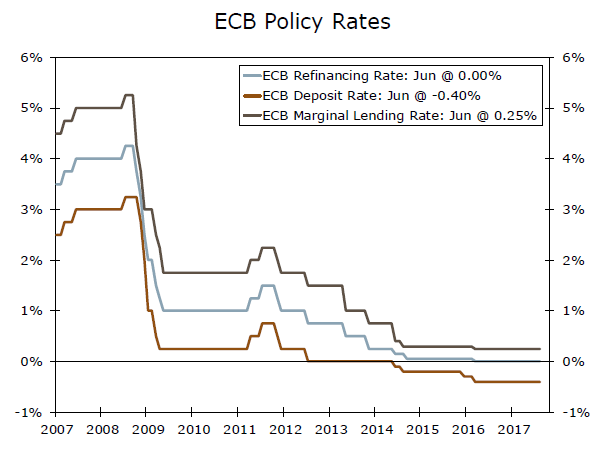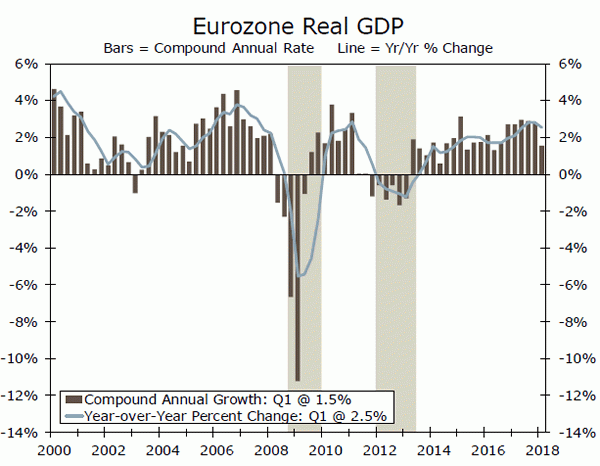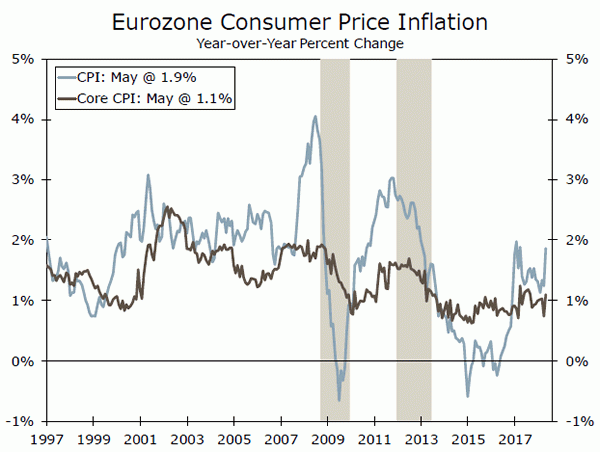The ECB will end its quantitative easing program at the end of the year, and the Governing Council anticipates that it will keep rates on hold through the summer of 2019.
QE to End in December, Rates on Hold Through Next Summer
The European Central Bank made some important announcements at its highly anticipated policy meeting today. First, the Governing Council reaffirmed its commitment to purchase €30 billion worth of bonds per month through September. But, as we have been forecasting, the ECB will dial back its asset purchase program to €15 billion worth of bonds per month in October. It also said that it will cease buying bonds altogether after December, assuming that the pace of economic activity and the inflation outlook evolve as the Governing Council generally anticipates.
Second, the Governing Council decided to keep its three main policy rates unchanged at the levels that have been maintained since March 2016 (top chart). Furthermore, the Governing Council said that it anticipates that it will keep its three policy rates at these levels “at least through the summer of 2019.” Previously, we had looked for the ECB to hike its deposit rate, which currently stands at -0.40 percent, sometime in the early summer of 2019 while keeping its main refinancing rate (0.00 percent at present) and its marginal lending facility rate (0.25 percent) unchanged. We then looked for the ECB to hike all three rates in late summer 2019.
We take the Governing Council at its word regarding its commitment to keep rates unchanged through the summer of 2019. Consequently, we need to make some tweaks to our forecast for ECB policy rates. We have pushed back our forecast for the first move in the deposit rate from Q2-2019 to Q3-2019. Specifically, we look for the Governing Council to lift its deposit rate from -0.40 percent to -0.20 late in Q3-2019 while keeping its main refinancing rate and its and its marginal lending facility rate unchanged at 0.00 percent and 0.25 percent, respectively. We then look for it to hike its deposit rate to 0.00 percent, its main refinancing rate to 0.25 percent, and its marginal lending facility rate to 0.50 percent sometime late in Q4-2019.
What could alter our forecast of ECB policy? Simply, changes to our macroeconomic forecasts. After strengthening throughout 2017, real GDP growth in the Eurozone slowed in Q1-2018 (middle chart). In our view, the slowdown in the first quarter was just a temporary soft patch, and we look for the expansion to remain intact for the foreseeable future. But if growth were to remain sluggish, then we would need to rethink our outlook for eventual ECB rate hikes.
Furthermore, there are few inflationary pressures in the euro area at present. Although the overall CPI inflation rate jumped up to 1.9 percent in May, the core rate of inflation remains depressed at roughly 1 percent (bottom chart). If the core rate of inflation remains well below the ECB’s target of “below, but close to, 2 percent over the medium term” then the Governing Council may keep the policy rate unchanged for even longer than we now anticipate.
















